The Little Townhouse In The Shadow Of 30 Rock
Last week, I was scouting office space in midtown, and I stopped by one of my favorite buildings on Sixth Avenue. At 850 feet tall, 30 Rockefeller Plaza is the 10th tallest building in New York…
…which is why I love the little townhouse standing next to it so much. On an avenue lined by some of Manhattan’s most iconic skyscrapers, this thing simply shouldn’t exist.
But there it is, and in fact, it’s not alone: there’s a second townhouse at the northern corner, with 30 Rock (technically, the 1250 Sixth Avenue portion of the building) sandwiched in the middle.
For the longest time, I’ve wondered why these buildings weren’t just torn down. When you look at Rockefeller Plaza from an aerial view, it’s simply insane that the entire complex was shifted to accommodate them. Can you even find them??
Here they are!
How did this happen? Back in 1892, three Irishmen, Paddy Daly, Daniel Hurley, and Connie Hurley, signed a long-term lease on the property at 1240 Sixth Avenue and opened a pub called Hurley’s. The pub became quite popular, and they even managed to survive prohibition by operating a speakeasy through the rear entrance on 49th Street.
Later, as Rockefeller gobbled up land throughout midtown at the end of the Great Depression, he was able to buy the building from its owners – but what to do about its tenants, whose lease trumped any attempts at eviction?
The pub owners made him an offer: $250,000,000 to buy them out (for comparison, $250,000,000 is the initial estimate of what the entire Rockefeller Center complex cost to build). Rockefeller said no; they refused to leave.
Meanwhile, at the opposite corner, 1258 Sixth Avenue was owned by one John F. Maxwell, who flat out refused to sell.
In the end, Rockefeller, one of the richest and most powerful men in the world, had no choice but to build his gargantuan skyscraper between the two townhouses. You can see them below as the entire operation goes on around them (Radio City Music Hall is on the right):
Hurley’s remained in business through the 1970s, and became a favorite for NBC employees, who referred to it as Studio 4-H. The pub finally sold and moved locations in 1979; a bar continued in its place until 1999. Today, it’s a Magnolia Bakery (1258 is now a Nine West shoe store).
One of my favorite views in the city is looking up at the towering 30 Rock while standing beside the diminutive 1240 Sixth Avenue – a reminder that sometimes, the little guys can still win:
Though it’s easy to miss it for the plethora of skyscrapers lining the block, be sure to give 1240 a glance next time you’re in the area.
Then, use it to picture a time when all the buildings along Sixth Avenue looked about the same.
-SCOUT
PS: For more information on Hurley’s Pub and 1240 Sixth Avenue, check out this excellent post by Daytonian in Manhattan.

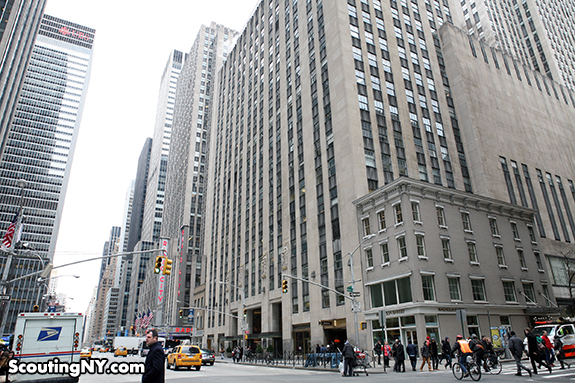

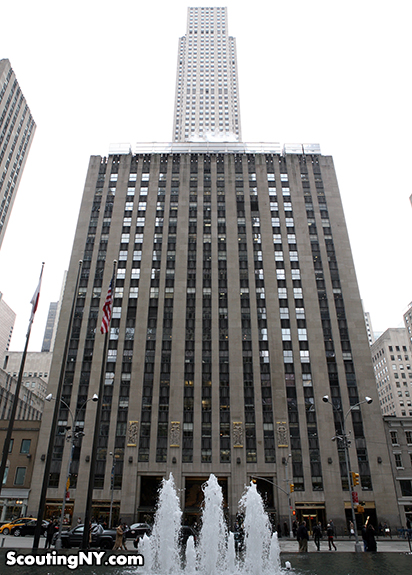
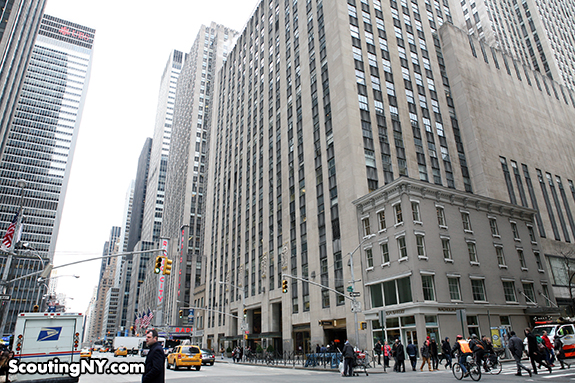


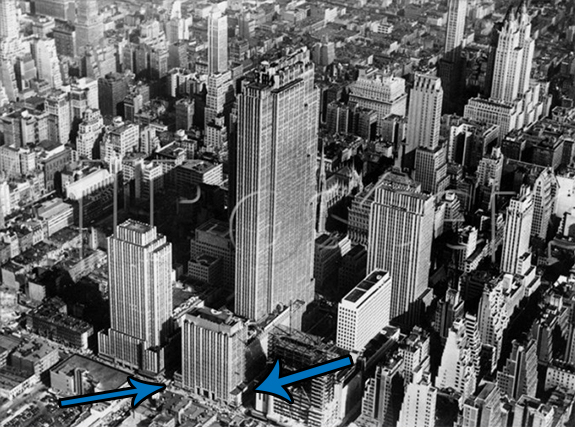
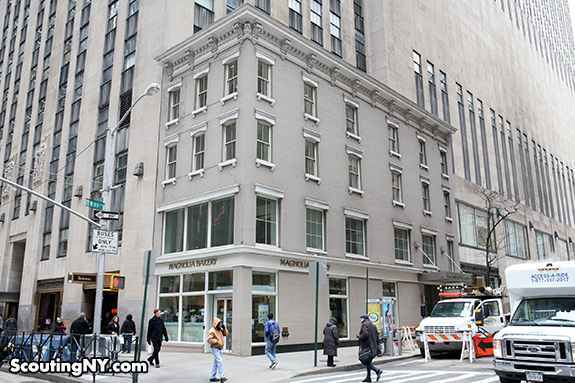
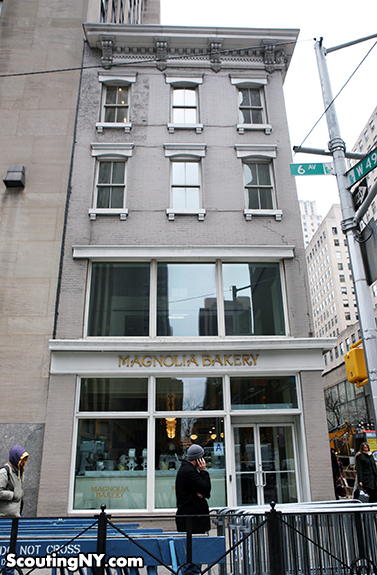

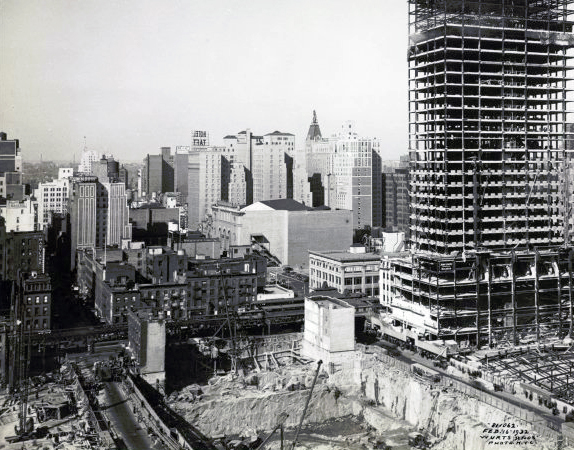
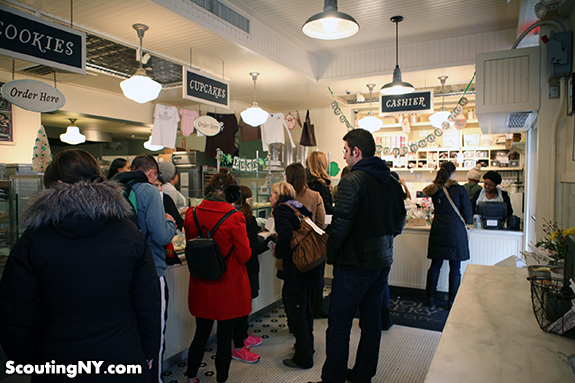
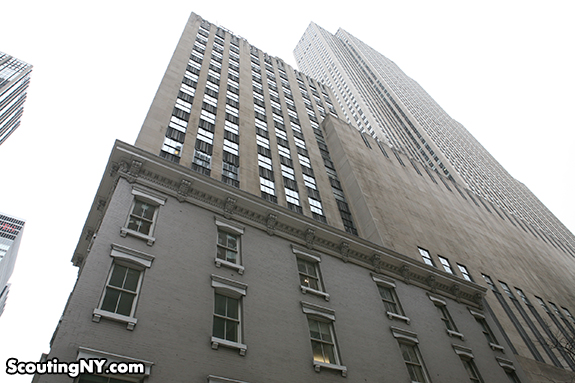
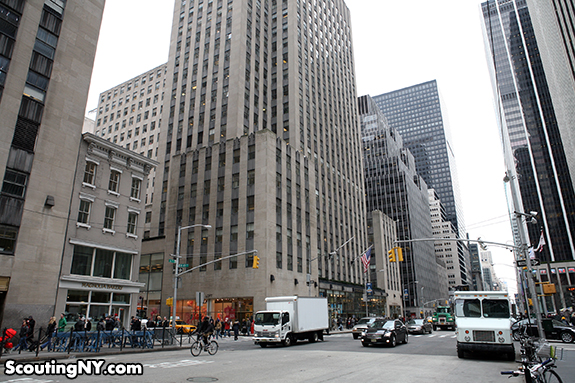
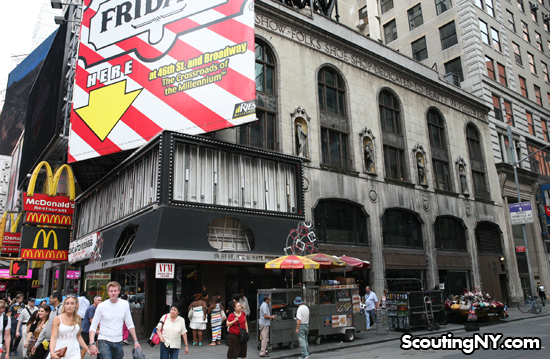
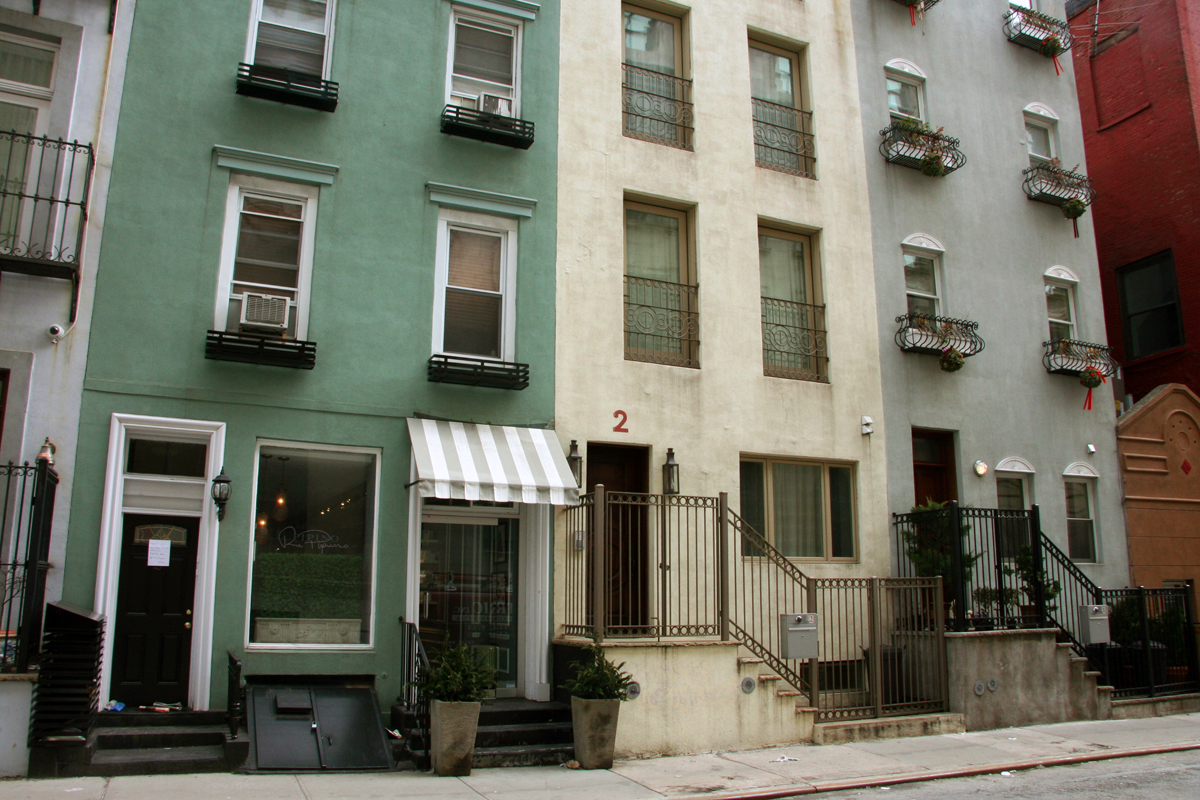
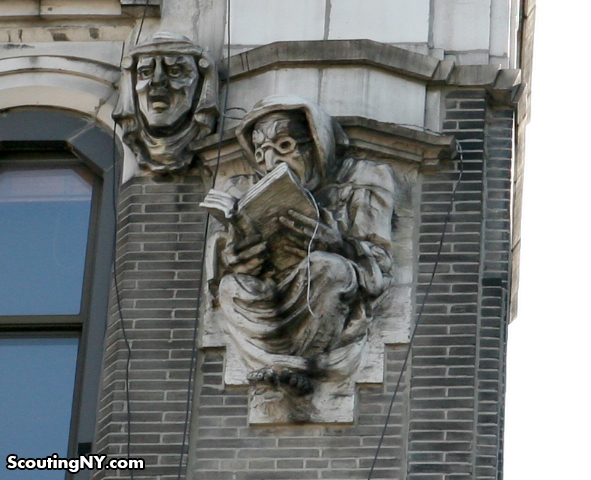

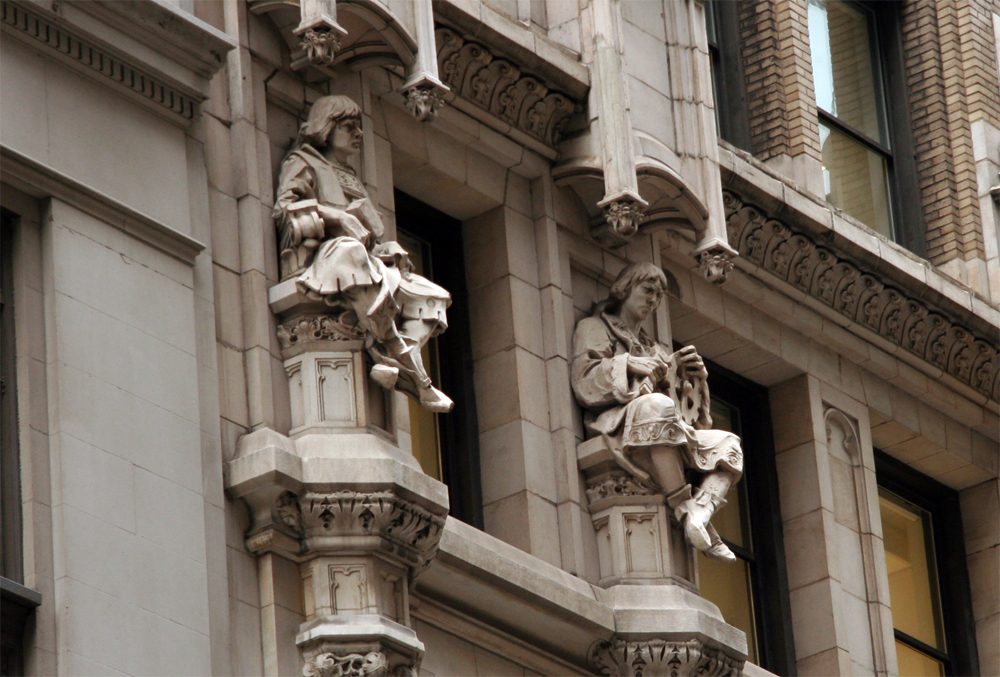
btw, it hasn’t been a Magnolia’s since 1999 (i know you didn’t say that, but just wanted to mention it in there.) it was a white table cloth restaurant for a while too. a google search says it was called Josephs Citarella. Then after they left, Magnolia’s came along a few years later.
Sad thing is that nowadays they would probably just eminent domain those two buildings if the owners refused to sell.
}}} Sad thing is that nowadays they would probably just eminent domain those two buildings if the owners refused to sell.
What’s this “probably” sh**, Kemosabe?
Eminent domain is exactly what would happen today if Trump becomes president. Back then they respected personal property rights. Back then they up held the Constitution of the U.S.A. That’s why it’s so important to get a solid Constitutional candidate in office not another progressive. There are 2 of those such candidates running.
That was then. Now Rockefeller would just get the city to seize the properties via eminent domain.
Eminent Domain was available at the time of Rockefeller. It has been a part of our country since the Articles of Confederation (perhaps even before). As a matter of fact, Eminent Domain laws are what protected the owners of those properties. You should at least make an attempt to understand the subject matter before commenting about it. This particular story is nothing new, and there are hundreds like it around the country. In nearly all Eminent Domain cases (except when targeted by government) the courts find in favor of the original landowner or occupant. It is only when government wants to steal the property (which they do frequently) that Eminent Domain abuses occur.
This story reminded me of the two small houses around which the Victoria Hotel in Amsterdam is built. The prices of these couldn’t be met, so they built around them instead.(see for instance http://www.panoramio.com/photo_explorer#view=photo&position=57&with_photo_id=47047010&order=date&user=2412504&tag=Amsterdam)
Another great post! I enjoy them very much. We just moved from Seattle to Wales and bought a 1912 Stone house. We passed up quite a few “listed homes” in our little Town of Barmouth because we figured it would drive us crazy to not be able to do things like put in double glazing in the period windows or a skylight. Sometimes I think preservation can go a little too far. We did not want to live in a beautiful but very cold and dark Georgian cave. We plan to undo the 80’s remodel at our place and take it back to the fab craftsman style it was built in.
If you ever need a wonderful location for a period film with wonderful sea, estuary and mountain views you can’t go wrong with ‘the stone houses on The Rock’ , in Barmouth.
It is interesting how the stone area on the right end of the tower is wider than the stone area on the left side. It looks like the intention was to center the front entrance in the middle of the block even though the two holdouts at each corner were not the same width.
It was Hurley’s back when the Tonight Show was at 30 Rock.
I love this story. I never really noticed them before – which is odd as I’ve been in that Magnolia’s before. Lol.
Work around the corner at 49th and 7th. I see these buildings almost every day. Did not realize there was such an interesting story behind them. Thanks!
Work not too far from there and never thought once about the two smaller buildings. Just became a bit smarter about my city. Thanks 🙂
used to work in 30 rock and always wondered about the magnolia building. never even realized there was a second townhouse. im curious, any idea whats on the top two floors? i assume they are offices for magnolia or kitchen space?
This reminds me of my youth in Queens when Macy’s was building a huge circular store on Queens Blvd in the mid-1960’s. There was one hold-out, an unassuming little house, which necessitated Macy’s changing their plans slightly. The following link tells some of the story:
http://gothamist.com/2012/08/06/macys.php
It was 1-H, not 4-H. The number refers to the floor, and Hurley’s was on the ground floor, hence 1-H.
Hurley’s was so popular with NBC employees, there was an extension behind the bar from their CIrcle 7-8300 switchboard.
P.J. Clark’s is another holdout. Also an Italian restaurant somewhere in the 50’s or 60’s on the east side did that and they built around it. Rose’s or something like that. Love those stories!
Check out Daniel Okrent’s excellent book on the construction of Rockefeller Center. It is called Great Fortune: The Epic of Rockefeller Center. He goes in to some detail about the townhouses and how the Center went up around them. I got my copy at a local bookstore but I am sure that Amazon or a good architecture bookstore can get you a copy.
Love it! A similar thing happened in Atlantic City back in 1993… http://en.wikipedia.org/wiki/Vera_Coking
No doubt this might well be where they got the idea for the macguffin behind You Can’t Take It With You
Terrific post. The photo of construction going on around the two holdouts is remarkable. Brilliant research. The other midtown hold out that I know of is the old Reidy’s bar on 54th, in 520 Madison Ave. I think that building was built by Continental Illinois bank, which spectacularly failed a few years later. Yet the holdout survived.
I think the best book on this subject is New York’s Architectural Holdouts by Andrew Alpern and Seymour Durst. The great thing about this book is that it is from the POV of a Durst, so his angle is “look at these annoying, idiotic, stubborn people. They’re crazy. And if we eventually wear them out and they take a buyout it shows they are just exploiting the developers to get rich. Here are some stories of the worst of them.” But when you read it you can’t help but LOVE the holdouts. At least I do.
And as mentioned, these days the city would just call the area blighted and crush them. Because it is just fine for the forces of “progress” to win in all cases, making loada of money and remaking the city to their vision.
http://www.amazon.com/Yorks-Architectural-Holdouts-Andrew-Alpern/dp/0486294250
Yeah, like Harry Maklow demolishing town houses in the middle of the night and neglecting to shut off the utilities
It looks like the same thing happened a few years ago with a big residential building called 777 Sixth Avenue. Do a Google image search and you’ll see what I mean. Two much smaller older buildings remain at the corners. To maximize retail storefront on Sixth Ave they put the residential entrance on 27th St around the corner, dramatic waterfall included.
Amazing both survived the foundation excavation and subsequent enormity. You gotta figure JD must have asked himself,”What if the foundations just kinda “failed”…” I mean look at the depth and breadth of the hole they dug!
One little element of the story needs tweaking: Rockefeller didn’t “buy up the land” for Rockefeller Center; the entire tract was owned by Columbia University and covered with buildings they rented. Rockefeller co-signed the lease to the entire site as part of an attempt to move the Met Opera uptown as part of a larger development. The Depression happened, the Met backed out, and JDR Jr ended up with the most expensive ground lease in history. He decided to go ahead with the project anyway for a number of reasons, one of which was to provide employment during the Depression.
So the holdouts weren’t properties Jr couldn’t buy, but rather properties which had long leases which could not be broken. These weren’t the only two, and some parts of the complex were designed so that the hold-outs could be replaced later.
There’s a great book about the whole saga of building the complex called “Great Fortune: The Epic of Rockefeller Center”. Definitely worth a read!
Ummm, Hurley’s was still Hurley’s at least until December of 1994, which is when I took my son there as the last stop on an epic pub crawl celebrating his 21st birthday. I knew of the place because I’d had dinner there a time or two in the company of a krewe which included the great NBC makeup artist Bobby Armstrong. Late at night, I mean VERY late at night, Hurley’s was then the after-hours hangout of food service people from throughout the Rock Center complex, not just NBC facilities. Some famous maitre-d or other explained the basics of Armagnac to my son.
That Hurley’s was not owned by the original guys, who sold out in 79 and left, taking the original bar with them. Sort of a tourist version of the original.
Worked at NBC 1980-84, & got into the habit of going to Hurley’s on my lunch hour (an ultimately fateful decision).
One day, about 1981, just as I was about to open the front door to enter, it flew open & out flew an airborne drunk, being ejected. Both of us landed on the pavement.
Adrian, the larger-than-life owner, came running out, picked me up & dusted me off. Apologizing profusely, he took me inside & treated me to anything I wanted on the menu.
The Bad Old Days, implausibly, had a few shining moments. This was one of them.
After Hurley’s moved out, the succeeding tenants were a cascade of real estate investment disasters, which is usually what happens when the Manhattan geniuses wake up at 3 a.m., inspired by a dream of unlimited riches. Glad I wasn’t around to witness any of these ventures first-hand.
You know, I’ve been to Rockefeller Center plenty of times, but I can honestly say I’ve never noticed these little guys! Definitely an awesome bit of NY Trivia to add to my arsenal. I’m glad to see they’re kept in great condition. It would be sad to lose them.
Appreciate you sharing, great article post.Thanks Again. Fantastic.
Reading this, I have to wonder if it wasn’t part of the inspiration for Frank Cappa’s “You Can’t Take It With You”, which has a similar sort of premise in it.
}}} one of which was to provide employment during the Depression.
NAWWWW…. he was an Eeeevil Rich Bastard…
They don’t care about things like that!!
Love this post, not just for the info but because two days ago I was staring at these two buildings and guessing that they must have been holdouts. I ran into this post entirely by chance while doing some French Connection research. Great work across this site. I’d nominate “Sweet Smell of Success” as a good candidate for a feature.
I too was an NBC employee 1980-2005. I spent many an evening in my early years gutting the free food at happy hour. Studio 1-H was always alive with NBC folks, some of whom you saw or heard on the air. There’s a great old Tomorrow Show with Tom Snyder from when the original Hurleys operators closed up shop in 1975. No video, but here’s the NBC archive listing of the show from October 15, 1975: http://www.nbcuniversalarchives.com/nbcuni/clip/5112448425_s01.do
Similar to the corner of Macy’s at Herald Square. The holdout being the corner store under the big Macy’s sign.
Look closer and you can see that the goliath department store absolutely was built to accommodate that one holdout.
Great story – pleasingly, these two townhouses are also included in the Metal Earth Rockefeller Plaza 3D Laser Cut Model (I’m not going to post a link, like a shill, but you can find them via Google!).
It made me smile and remember this post when I put mine together and found them on either side!
I work right by there. I love seeing the little townhouse.
Someone above said, “nowadays they would probably just eminent domain those two buildings if the owners refused to sell.”
I don’t think this is true. It is my understanding that “Eminent Domain” may be applied to the required PUBLIC use of a site. Rockefeller Center is a private complex. Therefore Eminent Doman could not be applied.